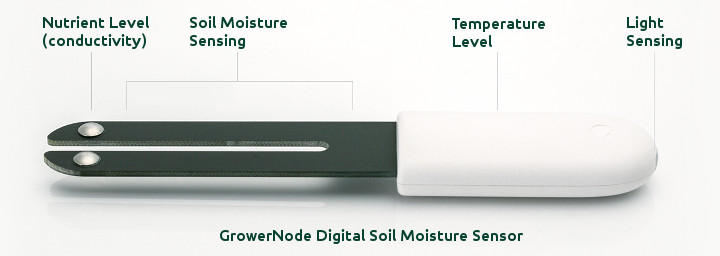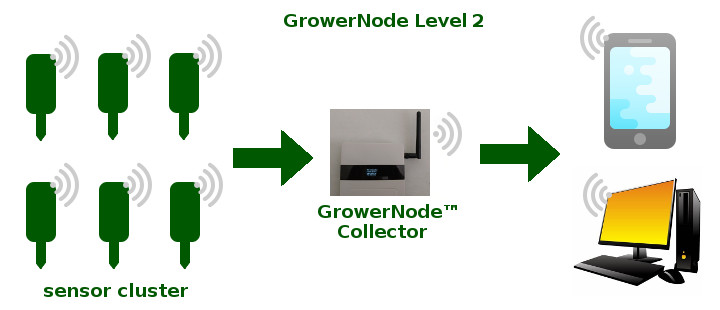Wireless Soil Moisture Sensors for Control of Irrigation & Nutrient Flow

GrowerNode
Realtime
Optimal
Wireless
Sensors
Wireless Soil Sensor Data is Forwarded Over the Internet

These soil and substrate sensors use the BLE (Bluetooth Low Energy) protocol for digital radio transmission, using coin cell button batteries that operate for over a year, depending on how often you wake them up to poll the data. These weatherproof sensors work in any environment and in any substrate, whether you are using soil. coco coir, perlite, peat moss, Rockwool, vermiculite, etc.
Sensor Data Transmission Range is Around 60 Feet
The main downside of these BLE soil sensors is the limited range of about 20 yards (18 meters). This is why we developed our Collector unit - it forwards the data from a cluster of these sensors to your WiFi router, then onto the Internet from there.
You can keep the data "in house" if you are concerned about security, or you can send it to a cloud app such as Digital Ocean; we provide you with full control over how your data is managed.
The system uses the Collector to forward the data from the wireless soil sensors, and the built-in web server and OLED display make it very user-friendly!

The Collector unit connects by digital radio signal to all soil sensors within about 60 feet. The web server provides a checklist screen which allows you to choose which sensors you want included in the group. The data from these BLE sensors is subsequently forwarded to a destination host; it can be a local computer in-house, or it could also be a service on the cloud, such as Digital Ocean, as depicted below.
The Raspberry Pi is a Great Choice
We are big fans of the Raspberry Pi; this very capable and affordable computer, running a version of the Linux operating system, was designed at Cambridge University primarily as a low cost solution for students to learn programming.
It has enough power to run the awesome Node-RED visual display system for your data, AND do regular computer activities like sending email, browsing the net, running a spreadsheet, etc, with a graphical user interface that is very similar to any other computer these days.
There is a huge user community, with vast resources about how to do things with it, and if you have a particular application for it, chances are that someone has already done it and written about it in the user forums.

Need More Info? See Article Series Below ...
You can purchase the soil moisture sensors, along with the Collector units in our sister DIY online store DIY online automation store.
We sincerely hope you enjoy our advanced technology products; if you have any questions, please contact us at any time!
Adrian Biffen
Senior Partner
GrowerNode™ Greenhouse Automation
G.R.O.W.S. System Article Series
|
G.R.O.W.S: GrowerNode Realtime Optimal Wireless Sensors |
The Collector:Part 1: Wireless Soil Sensor Collector Overview Part 2: Menu: Wireless Sensor Detection Process Part 3: Menu: Wireless Soil Sensor Testing Process Part 4: Menu: Wireless Soil Sensor Sleep Modes Part 5: Menu: Edit Collector Settings Part 6: Menu: Restore Collector Defaults Part 7: Menu: Activate Factory Re-set |
|
Part 1: Wireless Soil Sensor Overview (You are here) Part 2: Wireless Soil Sensor Activation |
|
The Cloud:Part 1: See Your Data from Anywhere |
